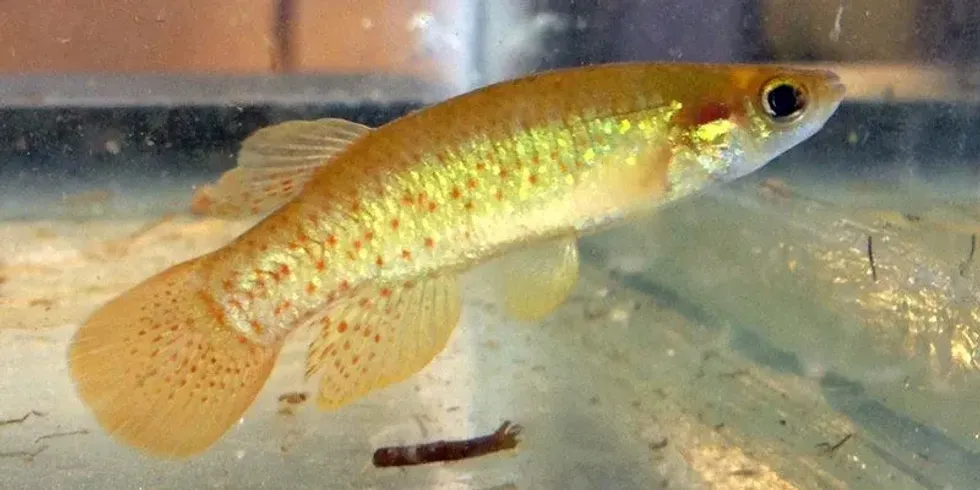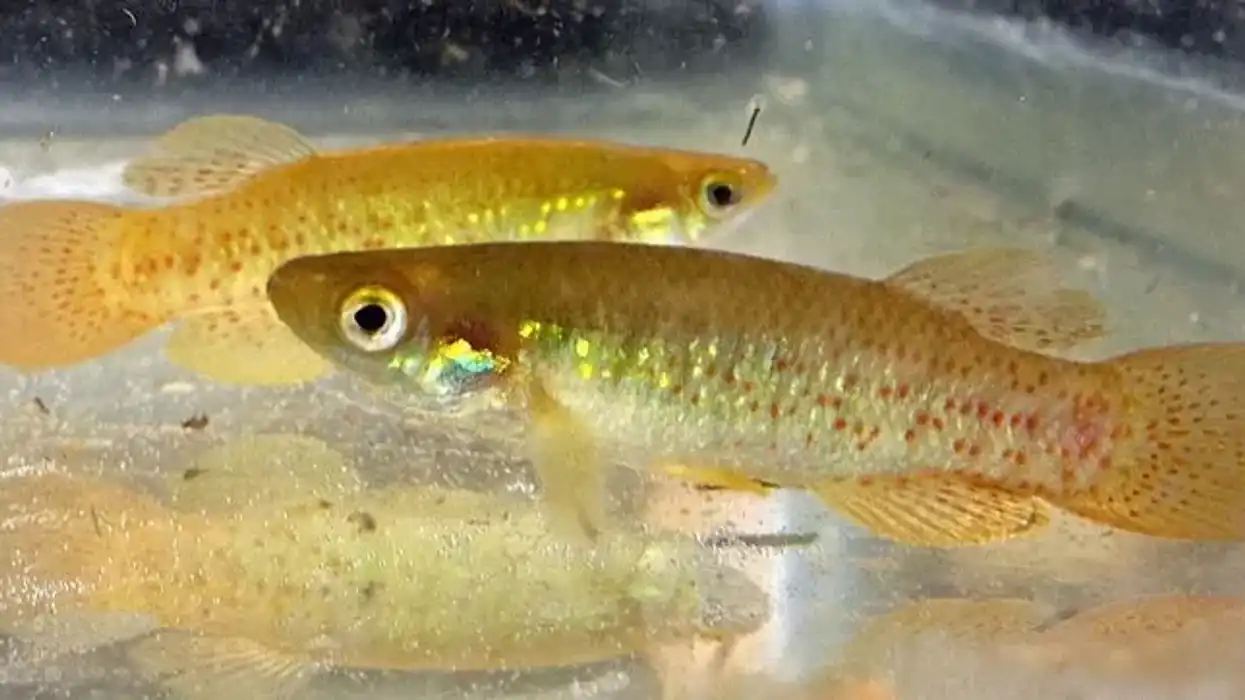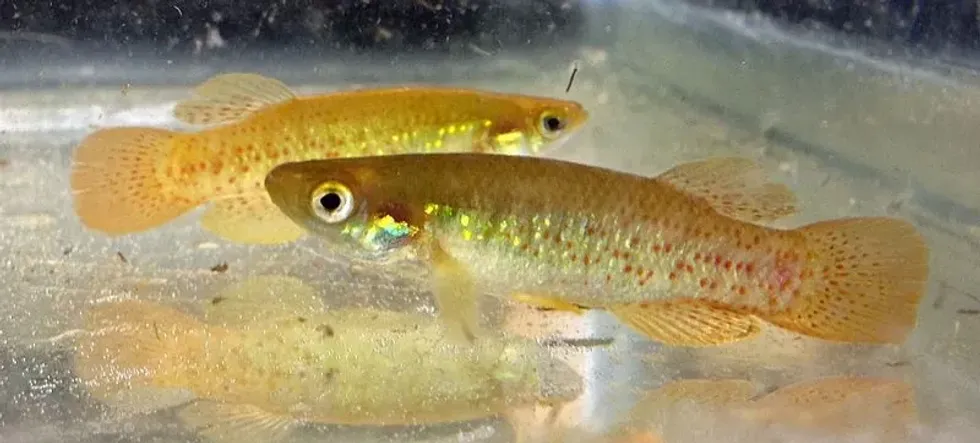Fun Golden Topminnow Facts For Kids

Have you ever heard about the topminnow fish? As the name implies, the topminnow fishes spend most of their time on the freshwater surface. Many freshwater fishes are popular aquarium fish, and many others play an essential role in comparative and environmental study. But, unfortunately, these fishes are also used as bait to catch the big game fish.
The topminnow fishes belong to the class- Actinopterygii, family- Fundulidae, and the order- Cypriniformes. Some North American killifishes also come under the family Fundulidae.
Around 44-46 species of topminnow fishes are widely distributed in the lowlands of North and Central America, starting from southeastern parts of Canada to the Yucatan Peninsula in Mexico, the Mississippi River, and its tributaries, the islands of Bermuda and Cuba.
One of the exciting and glimmering fish species of the topminnow is the golden topminnow. The body is covered yellow-green with gold patches on the side and vibrant red to red-brown spots on the posterior side of the body. Around seven preopercular pores are present.
Don't you want to know more about the golden topminnow (Fundulus chrysotus)? Read more about this fish. Also, check out the catfish and Pacific salmon for more interesting content.
Golden Topminnow Interesting Facts
What type of animal is a golden topminnow?
The golden topminnows are one of the freshwater fishes. It is a small surface-feeding fish. It reproduces late in the spring months and the early months of the summer. Though the fry reaches maturity at an early stage, however, the life expectancy of the Fundulus chrysotus is relatively short.
Since it is a small river fish, it falls in the lower trophic level and mainly feeds on the small Aquatic vegetation and floating organisms found near the water's surface or vegetated areas.
What class of animal does a golden topminnow belong to?
The Fundulus chrysotus (golden topminnow) is a fish. It belongs to the class Actinopterygii and the family Fundulidae.
How many golden topminnows are there in the world?
The exact number of golden topminnows is unknown. However, it is not listed as an Endangered or Threatened species.
There are around 40 species of topminnows fish species are under the genus Fundulus, three species under the genus Lucania, and only one species is under the genus Leptolucania. Therefore, almost six species of topminnows fish species are found in Arkansas.
Where does a golden topminnow live?
The golden topminnow (Fundulus chrysotus) lives in the native coastal waters and brackish waters. It is broadly distributed in the lowlands of north, south, and central America. These freshwater fishes mainly inhabit the Santee River of South Carolina and the Trinity River of Texas.
It is also found throughout the Mississippi River and its tributaries to the Missouri River and Kentucky. Further south, it is found in Florida and Fundulus golden topminnow is scattered in this region. It is native to the coastal lowlands of North Carolina and Florida.
It has also been documented changing its course towards the northwest, stretching into the Gulf coastal plains in Mississippi County, Missouri, and McCurtain County, Oklahoma.
What is a golden topminnow's habitat?
Golden topminnows are freshwater fishes, so they are native to brackish waters and coastal waters. The golden topminnow's cold tolerance is relatively high. Therefore, it can live in a variety of temperatures and salinities. It has its distribution in the swamps, backwaters of creeks, sloughs, pools, small and medium rivers, and slow-moving streams. It is strictly a lowland species.
The golden topminnows are usually found near the vegetation growth. However, it occasionally occurs in the river waters near the Gulf coastal regions.
Who does golden topminnow live with?
The golden topminnow (Fundulus chrysotus) fishes live on their own or in packs.
How long does a golden topminnow live?
The life expectancy of the Fundulus chrysotus is around two years.
How do they reproduce?
The golden topminnow (Fundulus chrysotus) breeds during the spring and summer months, from April to July, and sometimes extending until late September. Therefore, the life cycle of Fundulus chrysotus is quite interesting.
Before mating, the male swims in a circle above or near the female. It also hops its head up and down due to excitement. They usually spawn near the roots of floating plants.
The females release the eggs individually, which are deposited on the roots of floating plants. The eggs are usually laid with a gap of one week or more. The eggs have a yellow stain and glutinous threads attached to the membrane of eggs.
These eggs are fertilized one at a time by the male. After hatching, the larvae are found resting on the leaves and at the bottom of the aquatic plants. Then, they begin to grow and become matured after ten months.
What is their conservation status?
The conservation status of the Fundulus chrysotus is Least Concern.
Golden Topminnow Fun Facts
What does golden topminnow look like?

The golden topminnow (Fundulus chrysotus) is 3.346 in (8.5 cm) length. Its backside is yellow-green, and it has dark and narrow predorsal stripes. The appearance of the males and females is slightly different.
The males have 7-11 vertical bars, which are blurred and have red spots on both sides of the body. The posterior is well developed. Males also comprise spots of shimmering blue or gold along the sides of the body and head. The underside of the body and the head region is white and silver.
The fins are usually yellow to white. But they have red spots on them. The caudal fin has four to five rows with red spots.
The dorsal and anal fins also have red spots. The golden topminnow's red-fin on both sides gives it a stunning appearance. The pectoral and pelvic fins do not have pigments, but along the fins rays, they have small melanophores.
The females and the young ones do not have vertical bars, red spots, and gold patches. But sometimes, they might have bluish dots on the side. Both the sexes do not have horizontal lateral stripe and suborbital stripe.
How cute are they?
The Fundulus chrysotus (golden topminnow) are cute little fish. They have a yellowish-green body with red spots, minor golden marks, and vertical stripes on the sides. However, the females and the young ones have uniform yellowish-green bodies with small blue spots on the sides. The females and the young ones also lack vertical bars, red spots, and gold patches.
You can keep the Fundulus chrysotus in your aquarium. They surely would make your aquarium look attractive and grab the attention of your guests.
How do they communicate?
Fundulus chrysotus are known to communicate by motion, gestures, or signals, especially when swimming in schools. They also release chemicals for communication that can be sensed by the taste and smell of their kind.
These forms of communication are the only way to help them navigate, alert them from approaching predators to keep away, to call for spawning and while fighting.
How big is a golden topminnow?
The golden topminnow (Fundulus chrysotus) is around 3.346 in (8.5 cm) length.
Thus, the Fundulus chrysotus is two times smaller than the Mexican topminnows.
How fast can a golden topminnow swim?
The exact speed of the golden topminnow (Fundulus chrysotus) is not mentioned.
How much does a golden topminnow weigh?
The weight of the Fundulus chrysotus is not mentioned. However, it weighs less than the Mexican topminnows.
What are the male and female names of the species?
Females are known as female golden topminnows, and males are known as male golden topminnows.
What would you call a baby golden topminnow?
A baby golden topminnow is known as fry.
What do they eat?
The Fundulus chrysotus feeds on aquatic plants and aquatic invertebrates. They feed on aquatic invertebrates like snails or sea slugs, seed shrimp, mayflies (Ephemeroptera), non-biting midge flies (Chironomidae), and water-beetles (Coleoptera).
The diet of Fundulus chrysotus does not include vertebrates, and their prey is mostly seed shrimp and midge larvae.
Since the Fundulus chrysotus are small fish located at the lowest trophic level, they also have many predators that feed on them. These include the largemouth bass (Micropterus salmoides), bluegill sunfish (Lepomis macrochirus), blue-spotted sunfish (Enneacanthus gloriosus), and redear sunfish (Lepomis microlophus).
Are they poisonous?
No, they are not poisonous.
Would they make a good pet?
Yes, they would make a good pet. You can keep them in your aquarium. They are sure to grab everyone's attention. However, for the golden topminnow, care and maintenance is essential for the fish to live longer.
The Fundulus chrysotus has a yellowish-green body with red spots and gold marks. The bright red spots on the body make it an excellent aquarium fish. In addition, the Fundulus chrysotus is known to have seven preopercular pores. On the Google search page, you will get a lot of data stating the commercial importance of this fish.
Did you know...
The word Fundulus is taken from the Latin name Fundus, which means the bottom of the habitat. The other word, chrysotus, is a Greek word that means gilded or golden.
According to data collected, the Fundulus chrysotus can tolerate a wide range of salinity levels. For example, at 7% and 14% salinity levels, the Fundulus chrysotus had a 100 % survival rate.
But at 21 % salinity level, the Fundulus chrysotus had a 91% survival rate. Then, it immensely decreased to 24 % at a 28% salinity level. Lastly, the survival rate was 0% at the 35% salinity level.
The salinity tolerances described above are accountable for its native range throughout the brackish waters and coastal waters of north, south, and central America. Only at the mentioned salinity level can it survive and reproduce. Some significant influences on the Fundulus chrysotus population distribution include habitat pollution, conversion of the brackish waters, and the marchlands into agricultural fields.
As the Fundulus chrysotus mature, they become slim and lean with a deep caudal peduncle and a rounded caudal fin. The mouth is small is located slightly higher.
The dorsal fin is situated far from the body and starts from the posterior region of the anal fin. There are seven to nine dorsal rays, 12-14 pectoral rays, between 9-11 anal rays, and six pelvic rays.
During the breeding season, the males are known to develop sticky contact organs on the sides of their bodies. These sticky organs are located between the dorsal and anal fins, the outermost rays of the pectoral fin, and the ends of the dorsal rays.
Do humans eat them?
No, humans do not eat the Fundulus chrysotus. They are not edible. The Fundulus chrysotus are only good as aquarium pet fish.
Do they bite?
No, the Fundulus chrysotus do not bite. The Fundulus chrysotus are not dangerous.
Here at Kidadl, we have carefully created lots of interesting family-friendly animal facts for everyone to discover! Learn more about some other fishes from our herring facts and black marlin facts pages.
You can even occupy yourself at home by coloring in one of our free printable golden topminnow coloring pages.
We Want Your Photos!
More for You
See All
Master of Computer Science

Abhijeet ModiMaster of Computer Science
An experienced and innovative entrepreneur and creative writer, Abhijeet holds a Bachelor's and Master's degree in Computer Application from Birla Institute of Technology, Jaipur. He co-founded an e-commerce website while developing his skills in content writing, making him an expert in creating blog posts, website content, product descriptions, landing pages, and editing articles. Passionate about pushing his limits, Abhijeet brings both technical expertise and creative flair to his work.
Bachelor of Arts specializing in English Literature, Masters of Art specializing in English and Communication Skills

Sonali RawatBachelor of Arts specializing in English Literature, Masters of Art specializing in English and Communication Skills
Sonali has a Bachelor's degree in English literature from Guru Gobind Singh Indraprastha University and is currently pursuing a Master's in English and Communication from Christ University. With considerable experience in writing about lifestyle topics, including travel and health, she has a passion for Japanese culture, especially fashion, and anime, and has written on the subject before. Sonali has event managed a creative-writing festival and coordinated a student magazine at her university. Her favorite authors are Toni Morrison and Anita Desai.
Disclaimer
1) Kidadl is independent and to make our service free to you the reader we are supported by advertising. We hope you love our recommendations for products and services! What we suggest is selected independently by the Kidadl team. If you purchase using the Buy Now button we may earn a small commission. This does not influence our choices. Prices are correct and items are available at the time the article was published but we cannot guarantee that on the time of reading. Please note that Kidadl is a participant in the Amazon Services LLC Associates Program, an affiliate advertising program designed to provide a means for sites to earn advertising fees by advertising and linking to Amazon. We also link to other websites, but are not responsible for their content.
2) At Kidadl, we strive to recommend the very best activities and events. We will always aim to give you accurate information at the date of publication - however, information does change, so it’s important you do your own research, double-check and make the decision that is right for your family. We recognise that not all activities and ideas are appropriate for all children and families or in all circumstances. Our recommended activities are based on age but these are a guide. We recommend that these ideas are used as inspiration, that ideas are undertaken with appropriate adult supervision, and that each adult uses their own discretion and knowledge of their children to consider the safety and suitability. Kidadl cannot accept liability for the execution of these ideas, and parental supervision is advised at all times, as safety is paramount. Anyone using the information provided by Kidadl does so at their own risk and we can not accept liability if things go wrong.
3) Because we are an educational resource, we have quotes and facts about a range of historical and modern figures. We do not endorse the actions of or rhetoric of all the people included in these collections, but we think they are important for growing minds to learn about under the guidance of parents or guardians.







